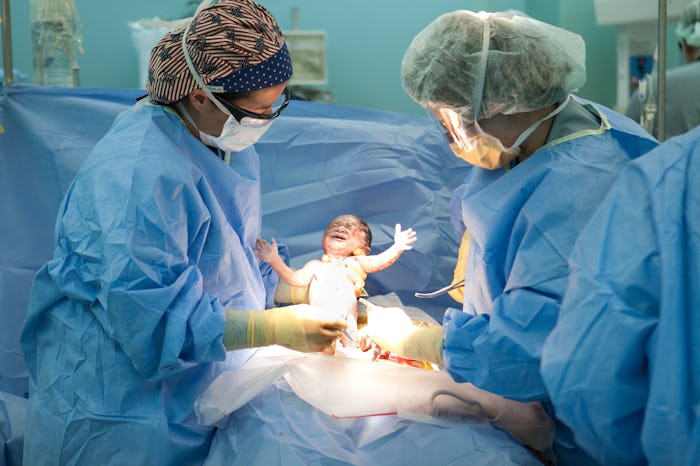Life

Stats On C-Sections Now Versus 20 Years Ago
Imagine you're sitting in the labor and delivery ward waiting room at your hospital. In between timing contractions and breathing through them, you look around and notice two other women doing the same, each of you at the precipice of birthing a new human into the world. In the United States, one of you will deliver via C-section, according to the Centers for Disease Control and Prevention. Statistics on V-sections now versus 20 years ago reveal that the number of women having C-sections is on the rise — with no signs of slowing down, despite the increased health complications associated with C-sections, for both mothers and children.
The U.S. C-section rate was first measured in 1965, where it came in at just 4.1 percent. Thirty years later, the rate would be more than five times higher and by 2015 — the latest year for which data is available — the U.S. C-section rate had climbed to 32 percent, according to the CDC. Perhaps one of the most alarming trends that have coincided with the rise in C-sections in the United States? The U.S. has the highest maternal mortality rate among developed nations, according to the World Health Organization. But while correlation does not equal causation, there is no denying that dying from a C-section is a real possibility.
According to a 2015 study, the U.S. rate of maternal mortality, that is, the number of women who died during childbirth, rose by 27 percent between 2000 and 2014. In 2014, the rate of C-sections was so concerning among the health care community that the American Congress of Obstetricians and Gynecologists and the Society for Maternal-Fetal Medicine released new guidelines for physicians to reduce the number of unnecessary C-sections. Aaron B. Caughey, lead author on the ACOG/SMFM recommendations, shared an alarming trend that coincided with the rise of C-section rates in the United States. Speaking to Consumer Reports, Caughey noted:
As the Cesarean rate went up from 1995 to 2007, we didn’t see a decrease in neonatal mortality in our country. In fact, if anything, we started to see an increase in maternal mortality.
While the United States doesn't have the highest C-section rates in the world, it is still far above the rate at which the World Health Organization identifies as the "ideal rate" for C-sections, between 10 and 15 percent. As of 2015, the United States is more than double the WHO target C-section rate.
There's no reason to be ashamed of or guilty for having a C-section, especially when it's medically necessary. According to the American Pregnancy Association, there are several medical reasons for C-sections, too, including for multiple births such as twins and triplets, if a baby is too large or in breech position, or if the mother has preeclampsia or an active case of genital herpes. Life-threatening conditions to both mother and/or baby such as uterine rupture, umbilical cord prolapse, fetal distress, or other emergency situations warrant C-sections as well.
No matter the reason for a C-section, it's important for expectant mothers to know their risks, and where the United States falls in the global picture of maternal health. It's baffling that, despite exponential advances in U.S. medical practices in the past 20 years, the health outcomes for C-sections aren't better — and yet, the practice continues to be the most common operating procedure in the United States.